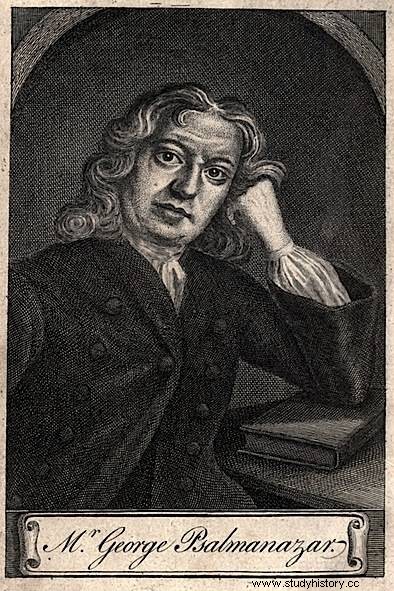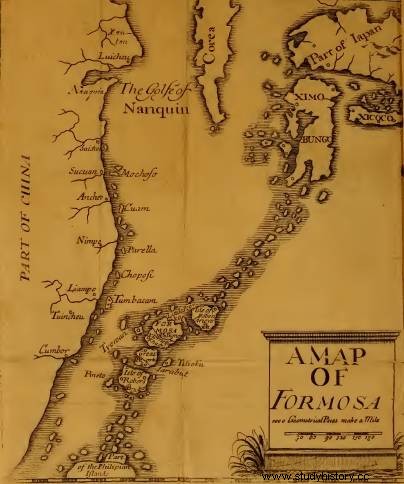The real name of George Psalmanazar is unknown to this day. He was probably born around 1680 in southern France. He was to be a very gifted child with a special talent for languages, including Latin. He was also extremely curious about the world - and it was precisely this desire to see what was hidden beyond the borders of his native land that made him one of the greatest ... fraudsters in history.
The turn of the 17th and 18th centuries was not a time when traveling was cheap and safe. George, however, had a plan. After learning a bit of English, he began to impersonate an Irish pilgrim on his way to Rome. Unfortunately, Ireland was not a country far enough away that its deception was quickly revealed. So he had to change his personality. This time he decided to go for something more exotic.
First he became a Japanese pagan, and in time he turned into a citizen of distant Formosa (today's Taiwan). In order to make his creation more credible, began to worship the sun and the moon, eat strange dishes (like raw meat seasoned with cardamom) and use the language of his own invention . Prepared in this way, he set off on a journey through Europe, reaching the Netherlands after some time, where he met the chaplain of the Scottish military unit, Alexander Innes.

photo:public domain To this day, the real name and surname of George Psalmanazar is unknown.
He was to baptize George, giving him the name by which he is known to this day - Psalmanazar. He received them in honor of the biblical Assyrian king Salmanasar V. After all, the two gentlemen left Rotterdam together and went to London, where the impostor would gain real publicity.
George arrived on the islands in 1703 and almost instantly became a sensation. In all and around he proclaimed that he was the first Formosan to set foot on the European continent. He built his popularity partly on people's curiosity about distant and inaccessible lands, as well as ... the great reluctance of the British towards Catholics.
Psalmanazar told stories about how cruel Jesuits kidnapped him from his homeland and deported him to France where they tried to impose the Catholic faith on him. This story was not without sense. At the time, the Jesuit missionaries were among the few who traveled to distant lands and were able to challenge George's stories. However, thanks to his story, many people have read the monks' accusations as lies covering up their cruel methods of converting to the papal faith.
The Tale of Formosa
Having secured his position in society, Psalmanazar began telling tales of the exotic Formosa, and the fascinating stories flowing from his lips charmed the English public:
Fake tales of his life and travels became a publishing sensation and quickly made him famous in England for countless lewd details (and more importantly, illustrations) about the victims from cannibalism, polygamy, infanticide and other macabre aspects of Formosan everyday life .
In his accounts, the inhabitants were naked and only their genitals were covered with gold or silver plates. Polygamy was the norm, and in the event of adultery, the husband had the right to eat the unfaithful wife - a nice change from the common snake diet. The murderers were hung upside down and stabbed with arrows. Once a year, a sacrifice was made to the gods from the hearts of eighteen thousand boys, which the priests consumed baked.
All this and more could be read in Psalmanazar's book An Historical and Geographical Description of Formosa, published in 1704. The publication presented not only the historical and cultural description of the country, but also the Formosan language. Interestingly, his description was so convincing that even years after the deception was exposed, it was presented as one of the first examples of constructed language.
Of course the work was selling like hot cakes, bringing Georg fame and money. The author traveled all over the UK, giving lectures and adding variety to banquets and other events. The blue-eyed, fair-skinned man, of course, over time began to raise uncomfortable questions in salons, but he was also able to deal with him skillfully.

Map of Formosa according to Psalmanazar
Why is my complexion so pale? After all, the Formosans live underground, without daylight. Yes, but I guess at noon the sun must be peeking at you through the chimneys; after all, it's a subtropical land, 'insisted Edmund Halley during a hearing at the Royal Society. Good point, the swindler agreed, but our chimneys are spiral and the rays do not reach the bottom.
Psalmanazar was so credible that he was even offered to teach the history of Formosa at the University of Oxford. Unfortunately, like most lies, that also had to come out in the end.
Age of ignorance
George Psalmanazar's stories raised doubts, but they were initially the voices of a few people - including those who did not enjoy the widespread trust and sympathy in Anglican Jesuit society. However, with the following years there were more skeptics who questioned the words of the Formosanczyk. And although the author admitted to the hoax with time, its full picture was only revealed a year after his death when the true autobiography of the impostor "Memoirs of ****, commonly Known by the Name of George Psalamanazar" was released.
It was in it that the trickster showed not only the scale, but also the meticulous way of preparing all the trickery. He based his description of Formosa on the then accounts of his travels to the remnants of Aztec and Inca cultures and Japan.
Interestingly, as the interest in him began to wane, George reached for his pen again - this time to write novels. Unfortunately, this fiction was no longer selling as well as his first work. He passed away in 1763. He has spent the last few years in retirement paid by one of his fans.
Today, the history of this deception may cause astonishment. How did so many people believe George's words? However, it should be remembered that the turn of the 17th and 18th centuries was a time when the knowledge of the inhabitants of Europe about other countries - especially those located on distant continents - was negligible. There was no mass media, and a very large number of Europeans were illiterate. But she craved for extraordinary stories that would stimulate the imagination and cause shivers of emotions.
